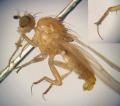Diptera.info :: Identification queries :: Diptera (eggs, larvae, pupae)
|
Tipula (Yamatotipula) ... ?
|
|
| solito de solis |
Posted on 25-05-2015 21:20
|
|
Member Location: Liege, Belgium Posts: 404 Joined: 05.08.13 |
Hey, here is a global view of the larvae moving in its environment  I've been surprised by this larva , 8 mm length, so different Vs the commun Tipulidae larvae I can see in a macroinvertebrate samples ordinary collected to realise Global index (IBGN), The larva is tiny (7 mm) and was living in filamentous algae with diffferent Chironomidae larvae and Cladocerans The shape of the 6 papillae (4 longs and 2 shorter), 6 subconical lobes and spiracles (2) and other features invite me to name Tipula (Yamatotipula) larva a view of its mouth  Is it enough to that ? a partial view of the whole habitus  and a view of the spiracular place a little bit crushed by the destiny  As the larva is very juvenile, I could not see really a lot of "hairs" or longitudinal dark lines but they are macroscopic setae present among little hairs as you can see on this picture  close-up to the spiracle, "dried"  Please, what could be the specific feature I have to observe to give a right name to this larva ? Merci beaucoup SDS Edited by solito de solis on 26-05-2015 06:43 |
|
|
|
| atylotus |
Posted on 27-05-2015 09:35
|
|
Member Location: Amsterdam, NL Posts: 1166 Joined: 29.05.09 |
Hello Solito it is a young specimen as you already thought and juveniles cannot be identified to species level and even subgenus is difficult. Although T. (Yamatotipula) is the most common subgenus encountered in stagnant waterbodies it is only a wild guess. There are more subgenera with these combination of anal papillae. So Tipula spec. it is. |
|
|
|
| solito de solis |
Posted on 27-05-2015 11:38
|
|
Member Location: Liege, Belgium Posts: 404 Joined: 05.08.13 |
Hello Atylotus Nice to read you I understand very well your opinion and vision of the facts and I will use Tipula spec to determine this larva You know that to evaluate quality water or biodiversity of a water sample, we use a 500µ sieve to filter the sample and so separate microinvertebrates and macroinvertebrates, as the normalised process ask it to do. So, we have sometimes very tiny larvae (between 500µ and 1mm) but we have nevertheless to determine them till the family (here Tipulidae was enough) but evolving standards will require increasingly determinations to species in the future...(when it's possible of course) Thanks a lot here is the clip The first part (00.00" to 38:00"  result of Wild Herrbrugg binocular stereomicroscop recording. result of Wild Herrbrugg binocular stereomicroscop recording.YouTube Video SDS Edited by solito de solis on 27-05-2015 11:40 |
|
|
|
| Jump to Forum: |












